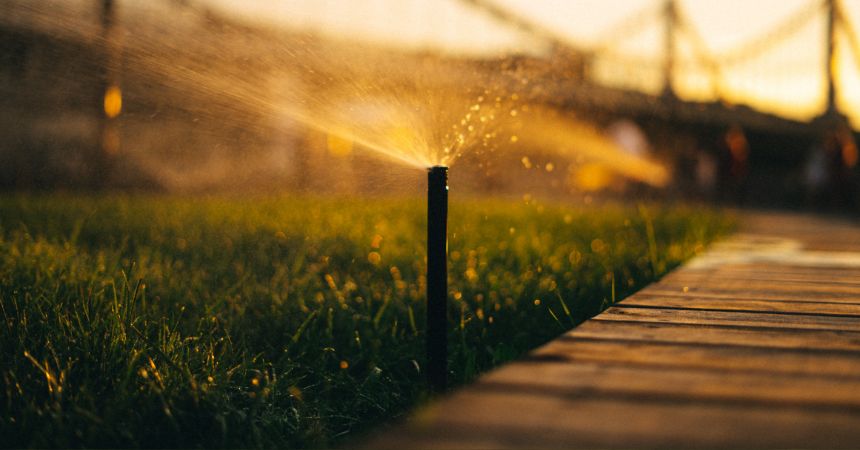When is the best time to water your lawn?
The best time to water your lawn is early in the morning, between 5 a.m. and 9 a.m. The colder temperatures and calmer winds enable water to soak into the soil and reach the root zone before evaporating. The sun in the morning also helps dry off extra moisture on the blades of grass, which lowers the danger of fungal illnesses.
Morning watering deepens root development, making lawns healthier and more stress-resistant, according to Clemson and Purdue University research. When you water the grass in the middle of the day, when the sun is at its hottest, a lot of the water evaporates before it can reach the grass. Watering at night is convenient, but pests and lawn illnesses grow on moist grass.
For a healthy lawn, early morning watering remains the most efficient and healthiest lawn care routine, ensuring your lawn gets the hydration it needs without waste or harm.

Why Does Timing Matter for Lawn Watering?
Watering at the right time of the day protects grass health and soil structure.
If you water during the hottest part of the afternoon, up to 50% of the water may evaporate before it gets to the roots. When it becomes dark and the air stops moving, water stays on the blades. Brown patch and dollar spot are two fungal infections that grow in this wet climate, according to the University of Georgia.
Water goes into the soil and down to the root zone at the right time, which helps the roots develop deeper. Shallow roots make grass prone to drought and stress, but deep roots enable turf to survive under harsh weather conditions.
When Is the Best Time of Day to Water Your Lawn?
Research from Purdue University recommends that watering in the early morning is best, before 9 a.m. Temperatures are milder, winds are calmer, and the sun is rising, allowing excess moisture to be removed off blades without wasting water.
Midday watering is not efficient, as much of it evaporates in the heat. Evening watering, though tempting for busy homeowners, leaves grass wet overnight. Prolonged leaf wetness encourages fungal growth and pest activity.
Experts agree that not all hours are the same when it comes to picking the right time of day.
Some hours can help your yard grow, while others can stress it out or waste water.
- Best time: Early morning (5 a.m.–9 a.m.)
- Okay if necessary: Late afternoon (4 p.m.–6 p.m.), but only if grass has time to dry before nightfall
- Worst times: Midday and night
When Should You Water Your Lawn in Different Seasons?
Most experts say that watering your lawn in the early morning all year long is best, but Oklahoma State University claims that the amount and duration of watering should change with the seasons to maintain your grass healthy and strong.
Here’s a more detailed breakdown by season:
Spring: When the grass starts to grow again, water it gently and not too frequently so that the roots may grow deep. Most lawns don’t require much water in the spring because they receive adequate rain. Too much water in the spring can make roots too shallow, which makes it easier for weeds to develop.
Summer: Usually, lawns need a weekly watering of 1-1.5 inches, done in deep, infrequent applications. Watering in the early morning is very important to lower stress and prevent diseases according to the University of Georgia.
Evaporation happens more quickly when it’s hot and sunny, and grasses that grow well in the warm months, such Bermuda and zoysia, grow the most.
Fall: If you’re overseeding cool-season grasses, keep watering them on a regular basis. Moist soil helps roots grow strong, which helps grass survive the winter. Air temperatures drop in fall, yet grass grows roots to recover. As temperatures decrease and natural rainfall rises, water less often.
Winter: You should generally avoid watering your lawn in winter, as most grasses go dormant and soil stays naturally moist. When it’s really dry for a long time in warmer places where the ground doesn’t freeze, you need to give your lawn a little extra water every once in a while to keep the roots from drying out.
The best way to water your lawn at different times of the year is to do very little in the spring, steady deep watering in the summer, supporting watering in the fall, and very little to none in the winter. Adjusting your routine to the seasons saves water and grows stronger, healthier grass.

What Mistakes Do Homeowners Make When Watering Lawns?
The most common mistakes homeowners make when watering lawns include watering at the wrong time of day, watering too frequently, and applying either too much or too little water. These errors not only weaken the grass and increase the risk of lawn disease but also waste water, according to Sod University.
For good root development, experts suggest deep, infrequent watering 1–1.5 inches each week, including rainfall. Mistakes like watering at night keep grass damp for hours and invite fungal infections. Similarly, daytime watering evaporates a lot of water before it reaches the soil.
Other mistakes include using automatic sprinklers without taking the weather into account, not paying attention to rain, or letting sprinklers apply into sidewalks and roads. These practices waste water and make the grass less healthy.
What Are the Signs Your Lawn Needs Water?
The main signs your lawn needs water are color changes, footprints that don’t bounce back, and wilting or folding grass blades.
Here are the key indicators to look for:
- Color change: Grass turns from a rich green to a dull bluish-gray or brownish shade.
- Footprint test: When you walk across the lawn, footprints or mower tracks remain visible instead of springing back up.
- Wilting blades: Grass blades curl, fold, or appear limp, showing stress from lack of moisture.
- Soil dryness: The top few inches of soil feel dry and crumbly instead of cool and moist.
- Patchiness: Dry spots appear in sunnier or sandy areas before spreading to the rest of the lawn.
If you notice these signs, it’s time for a deep watering session to rehydrate the soil and support healthy root growth.
What to Consider About Lawn Watering in Different Climates?
People who live in humid areas usually don’t need to water their lawns a lot, but people who live in dry or drought-prone areas need to be more strategic. They need to water deeply but less often, use efficient systems like drip irrigation, and choose grass species that can survive in dry conditions according to the University of Rhode Island.
Though coastal areas often have high humidity, which slows down evaporation, you still need to keep a close check on them since the sandy soils there drain quickly.
In cold or temperate areas, seasonal watering demands vary widely. Lawns require constant watering in spring and summer, but autumn irrigation should be decreased when rainfall rises and temperatures drop.
Except in extreme droughts and unfrozen soil, winter dormancy requires minimal irrigation. To prevent waste and maintain a resilient lawn, adjust watering methods to your region’s environment, balancing efficiency with grass health.
When Is the Best Time to Water Your Lawn in Tulsa, Oklahoma?
The best time to water your lawn in Tulsa, Oklahoma, is early in the morning, between 6 and 9 a.m. This is because the air is cooler, there is less wind, and the grass can soak up the water better. Tulsa has a humid subtropical climate, which means that summers are hot and humid and winters are moderate but may become cold.
The Oklahoma State University states that throughout the growth season, lawns usually require 1–1.5 inches of water per week. To build drought-tolerant roots that can survive Oklahoma’s summer heat, deep, infrequent watering is essential.
In Tulsa, warm-season grasses like Bermuda and zoysia are the most common. They flourish well in the summer but go dormant in the winter. Watering isn’t essential during dormancy (generally from November to March) unless the weather is very dry.
Sometimes, local rules may prohibit watering during droughts, so residents should check the City of Tulsa utility standards for the most up-to-date information.
